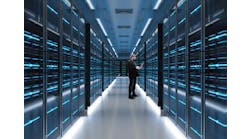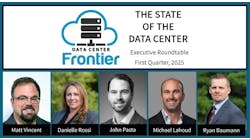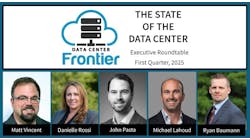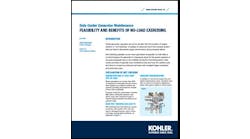Roundtable: Tips On Adaptive Reuse of Vacant Properties for Data Center Design and Development
As commercial real estate services giant JLL outlined in a recent blog, "the creative repurposing of older, under-utilized buildings has major environmental, social and economic benefits." 3 major benefits of such "adaptive reuse" in real estate, according to JLL, include reducing embodied carbon, promoting sustainable innovation practices, and preserving the cultural and historical value of older buildings, points calibrated to interest any contemporary data center operator.
For today's installment of Data Center Frontier's Q4 Executive Roundtable, our four data center industry leaders share their takes on adaptive reuse of vacant office, retail and other commercial real estate properties for data center design and construction development, which remains a gathering trend in North America, especially in urban markets facing slim availability of critical land and power stakes.
Our Executive Roundtable's expert panelists include:
- Zech Connell, VP, Program Development, BluePrint Supply Chain
- Nicole Dierksheide, Director - Category Large Engines>600KW, Kohler Co.
- Drew Thompson, Associate VP, Commercial, Connectivity and Industrial Group, Black & Veatch
- Mike Zapata, Head of Data Centers, Siemens Smart Infrastructure USA
Now onto the second question of the week for our Executive Roundtable for the Fourth Quarter of 2023.
Data Center Frontier: Especially in dense urban markets facing slim availability of critical land and power stakes, "adaptive reuse" of vacant office, retail and other commercial real estate properties for data center design and construction development remains a gathering trend in North America. For investors and providers thinking of adapting a site for reuse as data centers, what makes a particular property a better or worse candidate? And what are the relative considerations for brownfield vs. retrofit development in such cases?
Zech Connell, BluePrint Supply Chain: From our perspective, urban areas add a layer of complexity to construction management.
Physical and environmental risks to project execution are greater in urban areas. Even simple things like large load entrance and egress can be severely restricted in an urban setting.
Every type of building will not meet the structural requirements of a data center. Typically, a commercial office, distribution facility, or manufacturing facility is your best bet.
Brownfield options, while often increasing transportation distance, tend to be less risky and provide construction teams with more space to work with.
When a building is repurposed rather than constructed from the ground up, the space is typically delivered in less time. However, jurisdictions must be considered, as many now have zoning laws that include data center-specific requirements.
Nicole Dierksheide, Kohler: There are many individualized factors that go into determining whether or not a property will be a good candidate for reuse as a data center.
Key factors to consider are power infrastructure, location, connectivity, environmental implications, support of sustainability practices, and of course security.
These types of decisions need to be evaluated on a case-by-case basis as there are pros and cons to both scenarios.
For brownfield properties, you are working with a shell that could already house key elements that will be needed in the reuse project, and development might be faster because you are dealing with an existing structure. However, you are also at the mercy of what existed before and the property may need repairs, updates, etc.
You could argue that brownfield properties are more sustainable because you would not have to go through the process of constructing a new building, taking away more natural landscaping.
For retrofit properties, advantages are that the property is customizable and new with the ability to incorporate the latest technology and infrastructure available. However, challenges can include cost, long development times and issues with permitting and approvals that accompany any new construction.
In either case, we must do a better job of educating the public on the importance of data centers and the necessary services they provide.
Drew Thompson, Black & Veatch:
• Existing buildings that have high structural loading capacities are more attractive for retrofit, as upgrading the structure may be the largest cost and schedule hurdle to adaptive reuse. This is especially true in high density urban areas where the data center would be multiple floors.
• Access to sufficient electrical grid power for current and future expansion of data centers continues to limit expansion, making existing properties with agreements for large power capacity (ideally greater than 50 MW) very attractive top data center developers.
• Between the electrical power consumed by the computer systems, as well as the supporting infrastructure such as cooling, power costs are a significant operating expense and locations with lower utility costs are more attractive to data center developers.
• HVAC systems and backup generators are crucial to reliable operations of data centers, but contribute significantly to external noise levels. Sites with minimal acoustic requirements are more desirable to data center developers.
• Data centers are expensive, making sites with economic incentives more desirable. This could be in the form of tax exemptions from electricity consumption of data center equipment and tax credits for hiring workers.
• Zoning and permitting can be significant barriers to data center development, making locations with permitting and planning pre-approved for data center attractive.
Mike Zapata, Siemens Smart Infrastructure USA: Fundamentally, the first determinants will be the reliability, capacity, and availability of power, the connectivity options, and the local planning regulations.
These topics need to be fully digested initially to see if there is even an option to proceed. Then it becomes a structural question.
Many legacy office buildings will not have the necessary floor loading limits to accommodate a significant data center build.
However, some will, as we have seen with single-story facilities like warehouses that are being converted successfully in many metro areas. We’re not seeing this as much in the multi-story setting, except with a few notable examples in Chicago and Boston.
Repurposing an existing shell makes good sustainability sense, but will still require mechanical and electrical upgrades to make it meaningful for the IT workload requirements. Many of these requirements can be prefabricated offsite which can mean the possibility of a new data center with a minimal amount of on-site construction.
So it really depends, but it’s certainly worth exploring, because it can make sense. Siemens has experience working with clients that have taken this approach.
Next: Best Chances for Sustainable Data Center Onsite Power Generation

Matt Vincent
A B2B technology journalist and editor with more than two decades of experience, Matt Vincent is Editor in Chief of Data Center Frontier.










